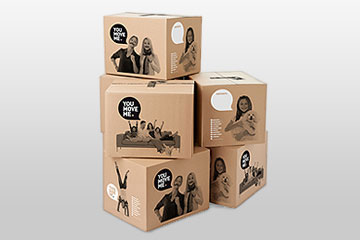14 Packing Tips for Moving

At first, the home moving process can look rather scary. Besides being overly expensive, the mere thought of trusting complete strangers with your valuable possessions will probably make you at a bit nervous. Add the arduous task of packing up your home for a move, and you’ll quickly learn why moving is often considered to be one of life’s most stressful events.
The good news is that when you use an awesome moving company like You Move Me, we’re here to help you through the entire process. Yes, that even means sharing our top packing tips to help you complete the packing job quickly and safely.
While it might seem daunting, packing for a move doesn’t have to be that complicated! Take full control of your packing task by following our top packing tips.
1. Decide who is going to pack up your home.
Professional packing services may be the best option when you’re moving long distance (ie: across the country) and you want the best protection for your valuable possessions. Professional packers won’t get the job done for free, of course, but they have been trained to work fast and know what it takes to ensure all your things are safe and protected.
If you own antique furniture, a piano, a pool table, or anything else that is valuable, then it’s better to rely on experienced professionals who offer proper insurance as well.
2. Pack by yourself and save money.
The single decision to pack on your own can easily save you hundreds of dollars. For most basic moves, you can definitely take care of it yourself.
If you’re moving only a short distance, have reliable friends willing to give you a hand, and don’t own any items that require special packing skills, then yes, you should try to pack up your home by yourself and save money in the process. Bear in mind that you’re going to need more time for packing, since it you’ll be learning the tricks of the trade as you go.
3. Create a packing calendar.
Once you’ve decided to tackle the packing job on your own, you’ll want to ensure you’re very organized. In truth, the process starts well before you’re ready to start filling up boxes.
Your first move should be to organize your time with the help of a packing calendar. Your personalized packing timeline will keep you on track, telling you what you should do next, and how much time you have to complete the task in order to stay on schedule.
4. Start the packing process early.
No, we don’t mean getting up at the crack of dawn on moving day! Rather, the idea here is that you should begin to pack up your things (pre-packing) as early as possible. In all honestly, you really can’t start too early.
It’s as simple as packing a few small items at a time. We suggest starting with the things you know you won’t need right away, and moving on from there. This method will ensure that you don’t get overwhelmed by last minute packing right before moving day.
5. Ask friends to lend a hand.
If you’ve got a large home or just have a lot of stuff, can you pack up your entire home without any help? If you can’t afford to hire professional packers, it’s a good idea to ask your friends to lend a hand.
If you think you’ll need to sweeten the deal a little, why not throw a packing party? Invite your best pals to help you out and provide them with drinks, snacks, and fun for their efforts. If you can swing it, you can even give them a small thank you gift.
6. Get hold of good packing materials.
You can’t start packing for a move without the necessary packing supplies, can you? What’s more, you’re going to need to secure packing materials of good quality, not just whatever comes your way. After all, your cherished home possessions are supposed to survive the relocation journey in them.
You’ll need white packing paper (soft), brown packing paper (hard), bubble wrap, packing peanuts, a few rolls of packing tape, a set of color markers, blankets or other pieces of old clothing, and newspapers.
Oh, and let’s not forget the most essential packing element of them all: packing boxes made of durable corrugated cardboard. LOTS of cardboard boxes! If you’re not sure where to find them, You Move Me sells used and new boxes and will even deliver them if you need!
7. Inventory your home.
The next challenge in your packing checklist is to decide what items you will pack and move, and what items you will get rid of prior to moving day.
To help you make these important decisions, you’re going to need a detailed house inventory. We suggest going from room to room and taking note of everything in each space, noting their current condition so that you can later assess whether or not you need to move those items at all.
8. Get rid of unwanted items.
This is perhaps the most valuable moving tip of all: don’t pack and move items that you probably won’t ever use again. Try to be ruthless about this one, for it’s your money that is on the line here.
Moving experts agree that if you haven’t used any items in more than a year, then you should seriously consider getting rid of them. It’s simple, really: any extra baggage will increase the transportation costs, as the total shipment weight will go up as well.
Attempt to sell, at a garage sale or online, all the things you’ve decided to leave behind. Everything that can’t still be used should be thrown out.
9. Do not pack items that are forbidden for transport.
There are some items that professional movers won’t be able to move. Each moving company has their own list of non-allowables that they hand out to their customers way before moving day, so make sure you have that list from the very start. Generally speaking, items not to pack when moving include hazardous items (flammable, corrosive or explosive items), perishables (food and plants), pets, and irreplaceable items.
10. Prepare an essentials box.
As the name suggests, an essentials box contains things of absolute necessity that you will need while your regular household items are in transit. This includes things such as toiletries, prescription medication, important documents, a change of clothes for each family member, basic kitchen items, basic tools, and so on.
Don’t forget to pack your open-first box the day before moving day, and more importantly –don’t hand it to your movers by mistake!
11. Pack safely.
Safety is a big concern during the packing process. After all, the idea is to make sure your valuable possessions remain well-protected during the trip. As far as safety goes, the best packing tips for moving house are:
- Always double tape the bottoms of cardboard boxes, even if they are brand new.
- Don’t skimp on packing supplies when packing fragile items – wrap them up in several sheets of bubble wrap and use plenty of padding materials to immobilize them in the boxes.
- Do not make boxes heavier than you can handle them – that’s especially true when packing books! The reasonable weight limit is about 20 pounds per box.
- If you own any specialty items that require professional packing skills, do not hesitate to contact experienced moving experts. Otherwise, you will be risking not only the well-being of your belongings, but your own safety as well.
12. Clearly label your boxes.
One of the most overlooked things in the packing prcess is to label your boxes properly. Do not make the mistake of thinking you’ll remember what’s inside each container just by the look of it. If you do, you’re likely to lose valuable time after the move when you get down to unpacking those same boxes.
What’s more, your movers won’t know which room to deliver the boxes if they are not labeled correctly, and that will lead to further confusion and extra wasted time.
Take your favorite marker and write the contents, destination room, and any handling instructions you think may help. Also, you can choose to use colored codes or a numerical labeling system to make the unpacking process much easier after the move.
14. Avoid common packing mistakes.
Sometimes it’s possible that even the best packing tips for moving may not be enough to keep you away from some of the worst packing mistakes you can possibly make. Packing mistakes can cost you time you don’t have, money you’d like to have, and nerves you’d like to spare.
Perhaps the worst mistake of them all is to think you can manage the packing process on your own, when you it’s obvious that you won’t be able to do it without professional assistance. Be realistic and honest with yourself: if you have too little time, have valuable items that you’re concerned about, or are nervous about packing, it might be time to hire professional packers.

